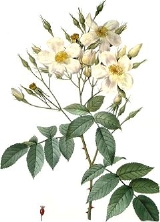
Rosa moschata
Encyclopedia
Rosa moschata is a species of rose
long in cultivation. Its wild origins are uncertain but are suspected to lie in the western Himalayas
.
The prickles on the stems are straight or slightly curved and have a broad base. The light- or greyish-green leaves have 5 to 7 ovate leaflets with small teeth; the veins are sometimes pubescent and the rachis
possesses prickles. The stipule
s are narrow with spreading, free tips. Small, ovate fruits called hips are borne, turning orange-red in autumn.
This species has historically been confused with Rosa brunonii, a closely related, tall-climbing species from the Himalayas that bears flowers in late spring and which possesses a similar, musky scent. They can be distinguished in gardens by their season of flowering and by their differing growth habits.
The variety 'Plena' bears semi-double flowers, and a form with study name "Temple Musk", found in the United States, bears more fully double flowers.
Rose
A rose is a woody perennial of the genus Rosa, within the family Rosaceae. There are over 100 species. They form a group of erect shrubs, and climbing or trailing plants, with stems that are often armed with sharp prickles. Flowers are large and showy, in colours ranging from white through yellows...
long in cultivation. Its wild origins are uncertain but are suspected to lie in the western Himalayas
Himalayas
The Himalaya Range or Himalaya Mountains Sanskrit: Devanagari: हिमालय, literally "abode of snow"), usually called the Himalayas or Himalaya for short, is a mountain range in Asia, separating the Indian subcontinent from the Tibetan Plateau...
.
Form
R. moschata is a shrub (to 3m) with single white 5 cm flowers in a loose cyme or corymb, blooming on new growth from late spring until late autumn in warm climates, or from late summer onwards in cool-summer climates. The sepals are 2 cm long with slender points. The flowers have a characteristic "musky" scent, emanating from the stamens, which is also found in some of its descendants.The prickles on the stems are straight or slightly curved and have a broad base. The light- or greyish-green leaves have 5 to 7 ovate leaflets with small teeth; the veins are sometimes pubescent and the rachis
Rachis
Rachis is a biological term for a main axis or "shaft".-In zoology:In vertebrates a rachis can refer to the series of articulated vertebrae, which encase the spinal cord. In this case the rachis usually form the supporting axis of the body and is then called the spine or vertebral column...
possesses prickles. The stipule
Stipule
In botany, stipule is a term coined by Linnaeus which refers to outgrowths borne on either side of the base of a leafstalk...
s are narrow with spreading, free tips. Small, ovate fruits called hips are borne, turning orange-red in autumn.
This species has historically been confused with Rosa brunonii, a closely related, tall-climbing species from the Himalayas that bears flowers in late spring and which possesses a similar, musky scent. They can be distinguished in gardens by their season of flowering and by their differing growth habits.
The variety 'Plena' bears semi-double flowers, and a form with study name "Temple Musk", found in the United States, bears more fully double flowers.

